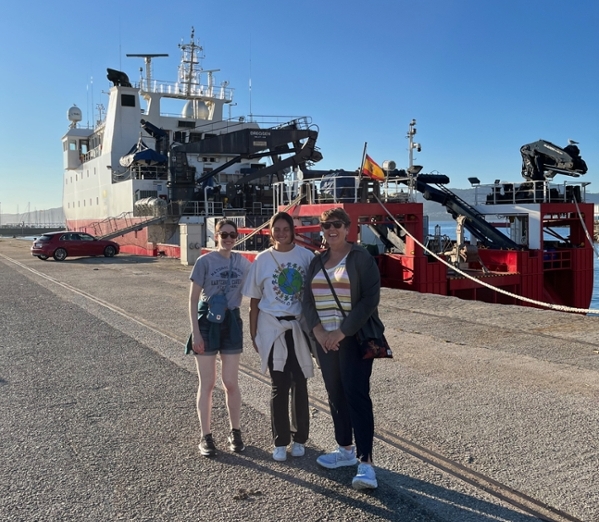Rowan-involved deep sea research probes climate change in North Atlantic
Rowan-involved deep sea research probes climate change in North Atlantic
Three Rowan University scholars – a faculty member, a recent graduate and a Ph.D. student – took part in a North Atlantic research expedition from August to September to study global climate change and the depths to which it is becoming ever more critical.
Beth Christensen, Ph.D., professor and founding chair of the Department of Environmental Science in Rowan’s School of Earth & Environment (SEE), said the deep sea excursion aboard the Sarmiento de Gamboa, a Spanish research vessel, included 15 international scientists whose mission it was to collect data to address one central question: how global climate changes are affecting saltwater organisms that help regulate climate and provide information about the health and history of the oceans.
Some of those organisms, like single-celled foraminifera, leave behind tiny calcium carbonate shells that act like data recorders of ocean conditions. Gathering on the ocean floor over millennia, those shells capture detailed information about the health and history of the sea.
“What they give us is a continual record of time that goes back millions of years,” Christensen said.
A veteran ocean researcher with 17 trips to her credit, Christensen has deep expertise in the study of ocean currents and their interconnectedness around the world. Joining her on the latest research cruise were Korie DeBellis, a Ph.D. student working on campus with Gerald Rustic, Ph.D., and Joanna Guldin, a recent Environmental Science (B.S. 2024) graduate who works with Lauren Kipp, Ph.D.
Christensen said ocean research expeditions have yielded a colossal amount of information, from deepening human understanding into the way earthquakes work to the frequency of El Niño weather patterns to a better appreciation for the ways in which climate has changed over time.
Some of her work aboard the Sarmiento de Gamboa, which sailed from Spain to the North Atlantic, involved a study of that region’s water currents.
“We wanted to look at the North Atlantic because it drives all of the oceans’ currents,” Christensen said.
Rising tides – and temps
Some of the data points she and her co-researchers collected confirmed a spike in North Atlantic ocean temperatures.
“There’s usually a big difference in water temperature between the Equator and the North Atlantic but the temperature difference is diminishing,” Christensen said.
That’s important, she said, because warmer water temperatures sequester less oxygen to the ocean floor where it can support marine life at all depths.
Christensen, whose previous research has included a study of sediment cores drilled from the ocean floor, said on this trip she focused on samples throughout the water column.
A detailed website of daily musings by scientists followed the shipboard research, which described some of the human-caused factors affecting the oceans and overall global climate.
The excursion included researchers from Brazil, Spain, France, Germany, Greece and the U.S. Once they left the Azores, and for much of their 30 days at sea, conditions were rough, with swells as high as 20 feet.
Clues to climate past and present
Guldin said part of her duties involved collecting water samples to support Kipp’s research, which includes measuring naturally occurring radium levels to gauge environmental changes that may be triggered by planetary warming.
Now exploring master’s degree programs in environmental science and oceanography, Guldin said taking part in the ocean research trip through Rowan, before even completing graduate studies, was “beyond amazing.”
“We collected 60 liters of water, which got filtered through cartridges to trap radium in fibers so Dr. Kipp can analyze them,” Guldin said.
DeBellis, who this semester began Ph.D. studies in paleoceanography at Rowan, said her first ocean research trip enabled her to collect sediments from the ocean floor to compare biodiversity from the past with samples from the present day.
“We want to reconstruct what the ocean was like hundreds of thousands to millions of years ago,” DeBellis said. “We’re reconstructing ocean temperature at the surface and trying to better understand the El Niño Southern Oscillation (ENSO) weather pattern.”
According to NOAA, ENSO is among the most important climate phenomena due to its ability to change the global atmospheric circulation, which influences temperature and precipitation across the globe. Telltale clues into how ENSO works can be gleaned from the study of foraminifera and other biodiversity in sediment cores.
Christensen said the trip was funded in large part by the government of Spain, which owns and maintains the research vessel. Funding through the SEE Dean’s office supported the cost of Christensen’s and DeBellis’ travel, while Guldin’s was supported by funding through Kipp’s National Science Foundation (NSF) grant.
Hoping to publish soon, Christensen is writing up findings from the trip and expects to use them to bolster applications for funding to continue ocean research.
“I will be submitting a research proposal to NSF to compare foraminiferal assemblages collected on the seafloor with the material we collected in nets, all the way to 200 meters below the surface,” she said. “This will help us better understand the ecology of benthic foraminifera and where in the water column they’re getting their food.”
(Photos: First image, from left, DeBellis, Guldin and Christensen.)


